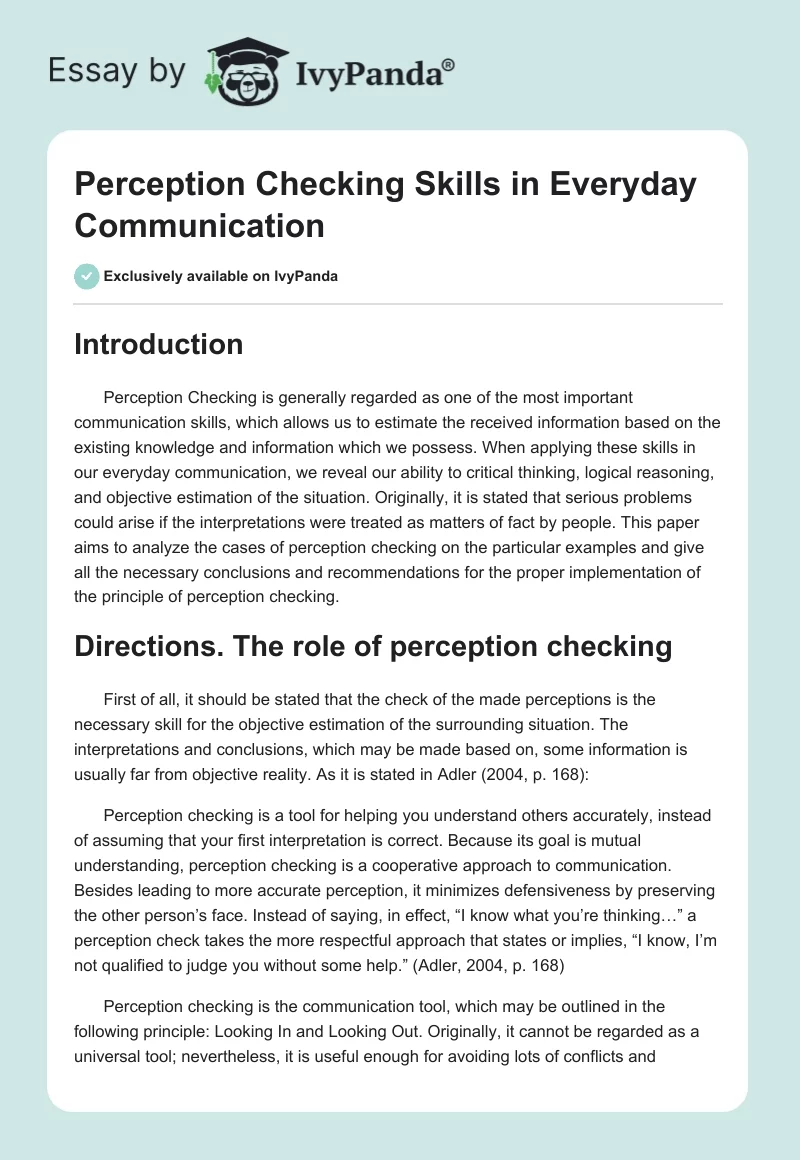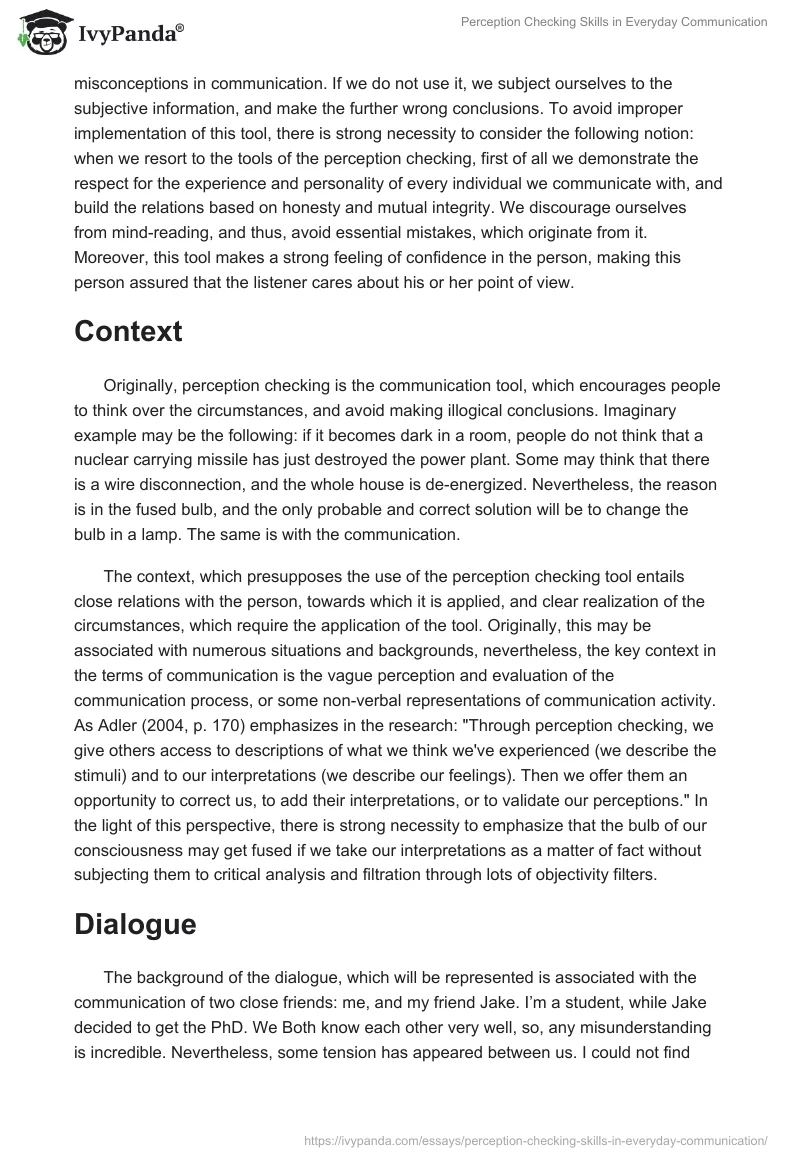Introduction
Perception Checking is generally regarded as one of the most important communication skills, which allows us to estimate the received information based on the existing knowledge and information which we possess. When applying these skills in our everyday communication, we reveal our ability to critical thinking, logical reasoning, and objective estimation of the situation. Originally, it is stated that serious problems could arise if the interpretations were treated as matters of fact by people. This paper aims to analyze the cases of perception checking on the particular examples and give all the necessary conclusions and recommendations for the proper implementation of the principle of perception checking.
Directions. The role of perception checking
First of all, it should be stated that the check of the made perceptions is the necessary skill for the objective estimation of the surrounding situation. The interpretations and conclusions, which may be made based on, some information is usually far from objective reality. As it is stated in Adler (2004, p. 168):
Perception checking is a tool for helping you understand others accurately, instead of assuming that your first interpretation is correct. Because its goal is mutual understanding, perception checking is a cooperative approach to communication. Besides leading to more accurate perception, it minimizes defensiveness by preserving the other person’s face. Instead of saying, in effect, “I know what you’re thinking…” a perception check takes the more respectful approach that states or implies, “I know, I’m not qualified to judge you without some help.” (Adler, 2004, p. 168)
Perception checking is the communication tool, which may be outlined in the following principle: Looking In and Looking Out. Originally, it cannot be regarded as a universal tool; nevertheless, it is useful enough for avoiding lots of conflicts and misconceptions in communication. If we do not use it, we subject ourselves to the subjective information, and make the further wrong conclusions. To avoid improper implementation of this tool, there is strong necessity to consider the following notion: when we resort to the tools of the perception checking, first of all we demonstrate the respect for the experience and personality of every individual we communicate with, and build the relations based on honesty and mutual integrity. We discourage ourselves from mind-reading, and thus, avoid essential mistakes, which originate from it. Moreover, this tool makes a strong feeling of confidence in the person, making this person assured that the listener cares about his or her point of view.
Context
Originally, perception checking is the communication tool, which encourages people to think over the circumstances, and avoid making illogical conclusions. Imaginary example may be the following: if it becomes dark in a room, people do not think that a nuclear carrying missile has just destroyed the power plant. Some may think that there is a wire disconnection, and the whole house is de-energized. Nevertheless, the reason is in the fused bulb, and the only probable and correct solution will be to change the bulb in a lamp. The same is with the communication.
The context, which presupposes the use of the perception checking tool entails close relations with the person, towards which it is applied, and clear realization of the circumstances, which require the application of the tool. Originally, this may be associated with numerous situations and backgrounds, nevertheless, the key context in the terms of communication is the vague perception and evaluation of the communication process, or some non-verbal representations of communication activity. As Adler (2004, p. 170) emphasizes in the research: “Through perception checking, we give others access to descriptions of what we think we’ve experienced (we describe the stimuli) and to our interpretations (we describe our feelings). Then we offer them an opportunity to correct us, to add their interpretations, or to validate our perceptions.” In the light of this perspective, there is strong necessity to emphasize that the bulb of our consciousness may get fused if we take our interpretations as a matter of fact without subjecting them to critical analysis and filtration through lots of objectivity filters.
Dialogue
The background of the dialogue, which will be represented is associated with the communication of two close friends: me, and my friend Jake. I’m a student, while Jake decided to get the PhD. We Both know each other very well, so, any misunderstanding is incredible. Nevertheless, some tension has appeared between us. I could not find Jake anywhere. Jake disappeared completely, and often did not answer the cell phone, which was the most surprising. I was too upset, as wished to help him relax, by inviting Jake to watch the new movie in a cinema, and then arrange a friendly conversation, as this had been practiced by them both before. I’ve considered that Jake avoids me. Nevertheless, the short dialogue between us helped to solve all the misunderstandings:
Hey! What’s happened? Are you avoiding me? Where are you missing all the time?
Sorry, Mike. Just have to accomplish lots of papers and I’ll probably have to dwell in the library. I couldn’t answer the phone, as it is forbidden to use the cells in the university library.
I guessed so. Probably I could help you…
Applying the Perception Checking tool I’ve made the simple conclusion, that Jake needs some help. Nevertheless, I did not voice this perception, as my friend could read in my eyes my offer. Originally, this may be regarded as the advanced level of perception checking, as both clearly understood each other. The perception-checking tool allowed both friends to understand each other, avoid offenses and maintain their friendship. This is the brightest example of how the lack of perception checking could ruin the close friendship, or at least crack it.
Analysis
The context and the dialogue, represented in the paper reveal the fact, that perception checking is attributable only to open-minded people, and require the acquiring of a particular communication style. The fact is that, this tool is impossible to use, if a person is originally unable to estimate the situation objectively and make a thorough analysis of the considerations and conclusions. Consequently, even if the person is aware of such communication skills, one will have to apply immense efforts to study using them properly and timely.
Nevertheless, it should be stated that this ability is a matter of constant practice, and the first step for developing this skill is empathy. In the light of this fact, the necessity to feel the needs and concerns of the other person is the important part of friendly communication and may be regarded as a feature of a psychologically adult person. Thus, if the concerns are realized, there is strong necessity to restructure the system of conclusions and considerations, which requires thorough analysis and proper study of the situation, taking into consideration the additional circumstances.
Originally, the use of this skill influences relations with other people positively. The fact is that, when people make several perceptions, it undermines the likelihood of subjective assessment of the situation. Consequently, any situation may be regarded from several angles, which makes it possible to gain a more sufficient data, and make an impression of reasonably thinking person. Moreover, it will be possible to preserve the relations with other people.
Conclusion
Finally, it should be emphasized that the communication skills and proper application of the necessary tools generally depend on the matters of personal features of every person. Originally, even though perception checking is a powerful and very useful tool of successful communication, it should be emphasized that it requires objective way of thinking and proper analysis of the surrounding circumstances. The analyzed dialogue also reveals the notion that this tool may be applied mainly in the communication of two close people, as it is difficult to analyze the behavior of an unknown person.
Bibliography
Adler, R. Perception: What You See is What You Get. Wadsworth Publishing, 2004.


